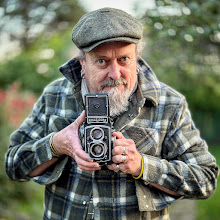Photographing model railways is a bit of a niche subject and requires odd techniques to get the best results. For proper commissioned shoots I use professional Nikon DSLR gear and studio lighting, but sometimes a tiny camera is needed for those hard to get and low angles when the more usual DSLR is simply too bulky.
For some time for this purpose I've used a little Canon G9, which has lots of manual control, the all important RAW capture delivering results good enough for a published double page spread. But after 20.000 frame the little G9 has finally expired so a replacement was needed quickly in the form of the highly regarded Canon G12.
The little camera arrived about an hour ago so I thought I'd better quickly put it through its paces, and here are my initial thoughts.
The controls are the same as with the G9 so I was able to set up my custom own custom settings of self timer and other bits that waste time setting up from scratch; Macro, IS off, 80iso, RAW.
Observations are as follows.
The wide angle is good, it equates to a 28mm which gives a good depth of field without focus stacking at f8 and offers a wider angle of view if needed. It delivers a far greater depth of field than the old G9 at the same f-stop at the widest zoom setting (G9 equates to 35mm). This will save time in post prod much of the time and of course disk space storing all those RAW files used for making up just images if focus stacking.
Shooting RAW for maximum quality and processing in Adobe Photoshop CS5, image quality wise has maybe tad lower noise than the G9 at base iso (80), but the lens has greater diffraction at f8 than the G9, so a little more sharpening is needed which in turn ups the noise, thus negating any real difference. But it is very acceptable and should be OK for DPS with good technique.
High contrast objects towards the edge of the frame suffer quite severe chromatic aberration (colour fringing), but this can be totally eliminated at the RAW processing stage buy ticking the C/A tick box in the RAW convertor, one of the reasons for shooting RAW and converting to JPEG later. You'll need full Photoshop, not PS Elements to be able to do this.
Another tickbox in the Adobe RAW convertor gets rid of the barrel distortion seen on straight lines towards the edge of the frame, this is only really an issue with architecture and a feature of all small camera zooms.
Conclusion for those thinking of upgrading:
For G9 owners;The extra wide angle is very good, but that's the only real difference. Image quality wise the difference is not really apparent enough to justify an upgrade (unless the camera is broken!)
G10/11 owners:Save the pennies and wait for the next model, or go for a G1x (but useless macro for model makers), or change to a DSLR.
General conclusionsThe multi-angle screen is a winner and will save bending necks too much.
Better video in the form of proper 16x9 which is compatible with TV set aspect ratios. 720p is not full HD, but will offer better res than SD and more than adequate for good online streaming. If you're buying just for the video, you'll be better with a bespoke video camera or DSLR which will offer far more control when recording.

